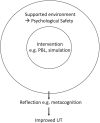Improving uncertainty tolerance in medical students: A scoping review
- PMID: 35797009
- PMCID: PMC9796811
- DOI: 10.1111/medu.14873
Improving uncertainty tolerance in medical students: A scoping review
Abstract
Introduction: Uncertainty is an inevitable part of medical practice. An ability to tolerate uncertainty is viewed as a key competency across many health-care systems. Poor uncertainty tolerance (UT) has been linked to negative outcomes including reduced psychological well-being in medical students. A variety of medical education interventions have been developed with the intention of increasing medical students' UT. However, there is no synthesis of these studies available to inform education and research practice. Our aim was to conduct a scoping review of medical education interventions that evaluate their impact on UT.
Methods: Medline, PsycInfo, Embase and ERIC databases were searched for articles published from inception to December 2020. An extensive supplementary search was conducted and both quantitative and qualitative evaluations were included. For each intervention, we categorised the stimulus of uncertainty (ambiguity, complexity and/or probability) and mapped the students' reported cognitive, behavioural, and/or emotional response(s) to uncertainty onto an existing conceptual framework.
Results: Twenty-two of 24 included studies reported a positive impact on medical student UT in at least one domain (cognitive, behavioural or emotional). Interventions included problem based learning-based curricula, medical humanities, simulation, reflection and assessment. We found in four studies that a negative response in the emotional domain was reported despite positive responses also being reported in the cognitive and/or behavioural domains.
Conclusion: We identified a range of medical education interventions which report a positive impact on medical student UT. Further research is required to understand why a single intervention may stimulate a negative emotional response alongside a positive cognitive or behavioural response. In turn, this could support stakeholders such as policymakers and institutions to adapt the medical curriculum to better prepare their medical students for practice by enhancing their UT.
© 2022 The Authors. Medical Education published by Association for the Study of Medical Education and John Wiley & Sons Ltd.
Conflict of interest statement
None.
Figures
Comment in
-
Uncertainty about uncertainty tolerance: The elephants in the room.Med Educ. 2022 Dec;56(12):1152-1154. doi: 10.1111/medu.14926. Epub 2022 Aug 24. Med Educ. 2022. PMID: 35980941 No abstract available.
-
Is uncertainty tolerance an epiphenomenon?Med Educ. 2022 Dec;56(12):1150-1152. doi: 10.1111/medu.14938. Epub 2022 Sep 27. Med Educ. 2022. PMID: 36124815 No abstract available.
Similar articles
-
'I was uncertain, but I was acting on it': A longitudinal qualitative study of medical students' responses to uncertainty.Med Educ. 2024 Jul;58(7):869-879. doi: 10.1111/medu.15269. Epub 2023 Nov 14. Med Educ. 2024. PMID: 37963570
-
Medical Student Experiences of Uncertainty Tolerance Moderators: A Longitudinal Qualitative Study.Front Med (Lausanne). 2022 Apr 25;9:864141. doi: 10.3389/fmed.2022.864141. eCollection 2022. Front Med (Lausanne). 2022. PMID: 35547203 Free PMC article.
-
Exploring conceptual and theoretical frameworks for nurse practitioner education: a scoping review protocol.JBI Database System Rev Implement Rep. 2015 Oct;13(10):146-55. doi: 10.11124/jbisrir-2015-2150. JBI Database System Rev Implement Rep. 2015. PMID: 26571290
-
Behavioural modification interventions for medically unexplained symptoms in primary care: systematic reviews and economic evaluation.Health Technol Assess. 2020 Sep;24(46):1-490. doi: 10.3310/hta24460. Health Technol Assess. 2020. PMID: 32975190 Free PMC article.
-
Impact of summer programmes on the outcomes of disadvantaged or 'at risk' young people: A systematic review.Campbell Syst Rev. 2024 Jun 13;20(2):e1406. doi: 10.1002/cl2.1406. eCollection 2024 Jun. Campbell Syst Rev. 2024. PMID: 38873396 Free PMC article. Review.
Cited by
-
Learning to navigate uncertainty in primary care: a scoping literature review.BJGP Open. 2024 Jul 29;8(2):BJGPO.2023.0191. doi: 10.3399/BJGPO.2023.0191. Print 2024 Jul. BJGP Open. 2024. PMID: 38097267 Free PMC article.
-
The impact of a prehospital simulation on medical students' resourcefulness, personal growth initiative, and uncertainty tolerance.AEM Educ Train. 2024 Oct 18;8(5):e11032. doi: 10.1002/aet2.11032. eCollection 2024 Oct. AEM Educ Train. 2024. PMID: 39429944
-
Intolerance of uncertainty and attitudes towards persons living with disabilities in medical students: Is there a correlation?Front Public Health. 2023 Mar 24;11:1149725. doi: 10.3389/fpubh.2023.1149725. eCollection 2023. Front Public Health. 2023. PMID: 37033010 Free PMC article.
-
Education Research: Embracing the Unknown-Introducing Clinical Uncertainty Into the Neurology Clerkship Curriculum.Neurol Educ. 2025 Jun 9;4(2):e200220. doi: 10.1212/NE9.0000000000200220. eCollection 2025 Jun. Neurol Educ. 2025. PMID: 40510518 Free PMC article.
-
The Learning-Teaching Nexus: Medical Students' Motivations to Engage in Peer-Assisted Learning.Clin Teach. 2025 Aug;22(4):e70108. doi: 10.1111/tct.70108. Clin Teach. 2025. PMID: 40492712 Free PMC article.
References
-
- General Medical Council: outcomes for graduates. 2018. https://www.gmc-uk.org/-/media/documents/dc11326-outcomes-for-graduates-...
-
- National Academies of Sciences EaM , National Academy of Medicine , Committee on Systems Approaches to Improve Patient Care by Supporting Clinician W‐B . Taking Action Against Clinician Burnout: A Systems Approach to Professional Well‐Being. National Academies Press (US); 2019. - PubMed
Publication types
MeSH terms
LinkOut - more resources
Full Text Sources



